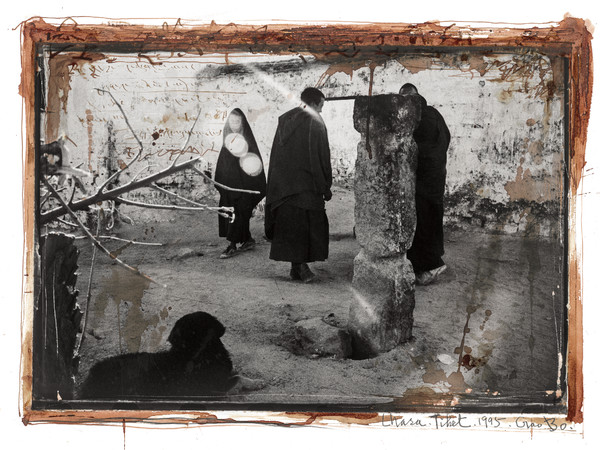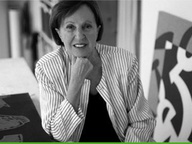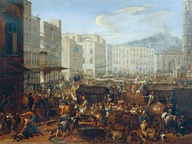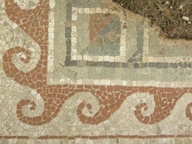GAO BO高波 OFFERTA Venezia-Himalaya

« TIBET 1985-1995, Photographs by Gao Bo » Tibet. 2009 Libro d'artista, edizione limitata con stampa in testa Copertina rigida, 680 x 500 mm, 260 pagine, Cina, novembre 2016
From 12 Marzo 2023 to 24 Aprile 2023
Venice
Place: IN’EI gallery
Address: Sestiere San Polo 1100
Responsibles: Pietro Gaglianò
With GAO BO高波 OFFERTA Venezia-Himalaya,the first solo exhibition in Italy by artist, photographer and performer Gao Bo (Deyang City, Sichuan, 1964), the new IN’EI gallery opens in Venice, a space intended to promote artists and work from China, Japan and Korea, and to create an open dialogue between these countries and Europe. From 12 March to 24 April 2023 the exhibition, curated by Pietro Gaglianò, displays a series of works, including a site-specific, ambient installation, to reveal the vision of this artist, born in China and living for many years in Paris. The exhibition is born of the experiences and traditions of these cultural and geographical areas, perfectly in tune with the gallery's objectives.
“The intention is to work with a few selected names, in whom we have decided to invest, starting lengthy journeys with both recognised and emerging artists, promoting these creators and producing ad hoc works specifically conceived for us,”explains Hélène Dubois, founder of the space together with Patrice Dumand. “Our aim is to present a proposal which includes and brings together art and design. In this first show, we wish to welcome an audience of enthusiasts, and present works and ideas deeply rooted in Asiatic culture, as well as introducing a specific sensibility and offering an interpretation of the relationships among different cultural pools”.
GAO BO高波 OFFERTA Venezia-Himalaya is almost a renaissance, marking the return of the artist to the international art scene after a long break.
The leading work in the exhibition, which inspired the project, is Mandala offering, Tibet, an ambient photography installation consisting of one thousand pebbles – the number which in Tibetan culture defines the Infinite – directly inspired by marniypebbles, a devotional feature of Tibetan Buddhist spirituality. On each pebble, Gao Bo has printed portrait photographs of women and men, young and old, and a series of numbers which recall the inhuman practice of numbering prisoners, an act of depersonalisation practised by all regimes.
This work, first created in 2012, and re-interpreted today, is born from the artist’s strong connection to Tibetan culture, and is not only an offering to the persons depicted, and to all their people, but also reflects on life, death, memory and on the relativity of time.
Neon highlights the non-verbal script created by Gao Bo, who chooses to employ a language which would never be used for violence, for abuse or oppression. “Il n’y pas de langue qui ne soit pas dangereuse” (There is no language which may not be dangerous) is the phrase in the display, expressing the artist’s vision.
Like an offering, the artist intends the work to complete its journey only when it is acquired by someone who will carry it back to Tibet. A back home which will be the subject of a documentary produced by the artist, together with the collector, closing a cycle and, like a kind of “liberation”, will open a new phase for Gao Bo.
Alongside the installation, the exhibition also includes A Thousand Silent Prayers, a brand-new work, a limited-edition portfolio in a special slipcase, 25 copies, signed by the artist, with ten engravings produced from the photographs of Mandala offering. Like a wordless list, the portrait faces also continue to interrogate the viewer in this new composition.
The journey is then completed with the artist's book TIBET 1985-1995. Photographs par Gao Bo, published jointly by the European Museum of Photography (MEP) in Paris, and Artron, the main publisher and printer of Chinese fine art books. This publication provides privileged access to the artist’s work and his relationship with Himalayan culture, through images chosen from the many thousands he has taken in 35mm, black and white film, between 1985 and 1995 during his various journeys in Tibet.
Consisting of a numbered, limited edition (1 to 50) of two portfolios, the book contains 146 prints, already held in the collections of some renowned museums and institutions around the world.
“His sensitivity towards the material, the subject of many of the works, and a particular feeling for time belong to the Asian part of Gao Bo’s cultural education”, emphasises Pietro Gaglianò, curator of the exhibition. “The lexicon used, the linguistic choices, the inclination towards the use of the figure, on the other hand, are choices from the European world. In this way, experimenting with new, deeply authentic combinations, observation of his work can provide an answer to an important historical question: the cultural consequences of European colonisation are still present, and it is more important than ever nowadays for artistic expression to be stamped by the neo-colonial condemnation of localism, typicality, and folklore, as by the trends dictated by market-based systems”.
Gao Bo’s idea of art, the search for which is founded in both of the worlds he inhabits, fully reflects that from which IN’EI was born, and which drives the gallery to create new connections between Eastern Asia and Europe, offering projects conceived to promote works and artists, identified through careful research in the field, and a thorough knowledge of East Asian art by its founders Hélène Dubois and Patrice Dumand.
“The intention is to work with a few selected names, in whom we have decided to invest, starting lengthy journeys with both recognised and emerging artists, promoting these creators and producing ad hoc works specifically conceived for us,”explains Hélène Dubois, founder of the space together with Patrice Dumand. “Our aim is to present a proposal which includes and brings together art and design. In this first show, we wish to welcome an audience of enthusiasts, and present works and ideas deeply rooted in Asiatic culture, as well as introducing a specific sensibility and offering an interpretation of the relationships among different cultural pools”.
GAO BO高波 OFFERTA Venezia-Himalaya is almost a renaissance, marking the return of the artist to the international art scene after a long break.
The leading work in the exhibition, which inspired the project, is Mandala offering, Tibet, an ambient photography installation consisting of one thousand pebbles – the number which in Tibetan culture defines the Infinite – directly inspired by marniypebbles, a devotional feature of Tibetan Buddhist spirituality. On each pebble, Gao Bo has printed portrait photographs of women and men, young and old, and a series of numbers which recall the inhuman practice of numbering prisoners, an act of depersonalisation practised by all regimes.
This work, first created in 2012, and re-interpreted today, is born from the artist’s strong connection to Tibetan culture, and is not only an offering to the persons depicted, and to all their people, but also reflects on life, death, memory and on the relativity of time.
Neon highlights the non-verbal script created by Gao Bo, who chooses to employ a language which would never be used for violence, for abuse or oppression. “Il n’y pas de langue qui ne soit pas dangereuse” (There is no language which may not be dangerous) is the phrase in the display, expressing the artist’s vision.
Like an offering, the artist intends the work to complete its journey only when it is acquired by someone who will carry it back to Tibet. A back home which will be the subject of a documentary produced by the artist, together with the collector, closing a cycle and, like a kind of “liberation”, will open a new phase for Gao Bo.
Alongside the installation, the exhibition also includes A Thousand Silent Prayers, a brand-new work, a limited-edition portfolio in a special slipcase, 25 copies, signed by the artist, with ten engravings produced from the photographs of Mandala offering. Like a wordless list, the portrait faces also continue to interrogate the viewer in this new composition.
The journey is then completed with the artist's book TIBET 1985-1995. Photographs par Gao Bo, published jointly by the European Museum of Photography (MEP) in Paris, and Artron, the main publisher and printer of Chinese fine art books. This publication provides privileged access to the artist’s work and his relationship with Himalayan culture, through images chosen from the many thousands he has taken in 35mm, black and white film, between 1985 and 1995 during his various journeys in Tibet.
Consisting of a numbered, limited edition (1 to 50) of two portfolios, the book contains 146 prints, already held in the collections of some renowned museums and institutions around the world.
“His sensitivity towards the material, the subject of many of the works, and a particular feeling for time belong to the Asian part of Gao Bo’s cultural education”, emphasises Pietro Gaglianò, curator of the exhibition. “The lexicon used, the linguistic choices, the inclination towards the use of the figure, on the other hand, are choices from the European world. In this way, experimenting with new, deeply authentic combinations, observation of his work can provide an answer to an important historical question: the cultural consequences of European colonisation are still present, and it is more important than ever nowadays for artistic expression to be stamped by the neo-colonial condemnation of localism, typicality, and folklore, as by the trends dictated by market-based systems”.
Gao Bo’s idea of art, the search for which is founded in both of the worlds he inhabits, fully reflects that from which IN’EI was born, and which drives the gallery to create new connections between Eastern Asia and Europe, offering projects conceived to promote works and artists, identified through careful research in the field, and a thorough knowledge of East Asian art by its founders Hélène Dubois and Patrice Dumand.
SCARICA IL COMUNICATO IN PDF
COMMENTI

-
 Dal 31 gennaio 2024 al 04 maggio 2025
Fermo | Palazzo dei Priori
Dal 31 gennaio 2024 al 04 maggio 2025
Fermo | Palazzo dei Priori
-
 Dal 20 dicembre 2024 al 04 maggio 2025
Fermo | Palazzo dei Priori
Dal 20 dicembre 2024 al 04 maggio 2025
Fermo | Palazzo dei Priori
-
 Dal 20 dicembre 2024 al 04 maggio 2024
Gorizia | Palazzo Attems Petzenstein
Dal 20 dicembre 2024 al 04 maggio 2024
Gorizia | Palazzo Attems Petzenstein
-
 Dal 18 dicembre 2024 al 18 dicembre 2024
Venezia | Museo Correr
Dal 18 dicembre 2024 al 18 dicembre 2024
Venezia | Museo Correr
-
 Dal 14 dicembre 2024 al 02 marzo 2025
Palermo | Palazzo Abatellis
Dal 14 dicembre 2024 al 02 marzo 2025
Palermo | Palazzo Abatellis
-
 Dal 12 dicembre 2024 al 23 febbraio 2025
Roma | Palazzo Altemps
Dal 12 dicembre 2024 al 23 febbraio 2025
Roma | Palazzo Altemps


